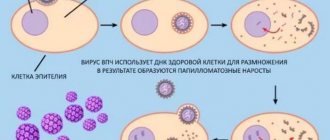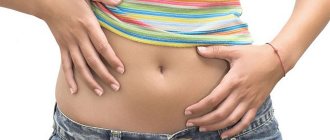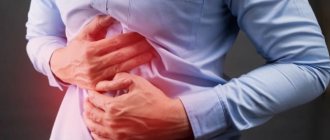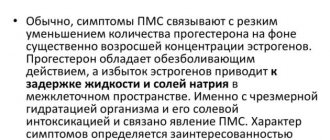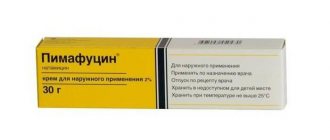What is PMS in girls and women: explanation
The abbreviation PMS has recently appeared in the vocabulary of gynecologists, in the texts of popular articles about women’s health, and in everyday communication. Premenstrual syndrome or PMS characterizes changes in the psychological and physiological state of women and girls before the approach of their next period.
Approaching period
Unusual emotional manifestations of behavior, irritability, conflict situations that arise out of the blue, headaches, “tears” for no reason, increased fatigue and much more can be expected by the female sex before the start of the monthly physiological phenomenon - menstruation.
IMPORTANT: According to statistics, 90% of women around the world suffer from premenstrual syndrome in one form or another. Doctors have discovered 150 symptoms and signs of an illness such as PMS.
Characteristic symptoms of PMS
It is unlikely that there will be women with the same picture of PMS: there are about 150 signs of premenstrual syndrome. However, in such a variety of characteristics, main groups can be distinguished. Symptoms of PMS in women:
- Deviations from the nervous system and psyche
A woman’s mood can be described in one word: negative. She may cry over a trifle or for no reason at all. Ready to “tear to shreds”, the degree of aggression also little coincides with the offense inflicted. At best, a woman is depressed and experiences irritability, which she cannot always cope with.
Due to increased progesterone levels for 1-2 weeks. Before menstruation, a woman’s mammary glands become noticeably enlarged and engorged. Many women at this time need a bra one size larger than usual. The bursting pain in the chest can be so intense that normal walking causes discomfort.
Symptoms and signs of premenstrual syndrome
There are many symptoms and signs associated with PMS. Let's list the most important ones.
Psychological symptoms of PMS
- Increased emotionality
- Excessive irritability and mood swings
- Excessive manifestation of conflict situations
- Inability to control one's own behavior
- Tearfulness
- Anxious state
- Premature fears
- Difficulty in correctly formulating thoughts
- Slow reaction
Low-grade fever with PMS
Physical signs of PMS
- Headache
- Pain and swelling of the mammary glands
- Increased fatigue
- Swelling of the face, legs, hands
- The appearance of rashes on the face in the form of pimples and acne
- Low-grade fever
- Pain in the lower abdomen
- Nausea
- Lack of appetite or increased interest in food
- Intolerance to certain odors
Symptoms and signs of PMS, video
Headache, swelling during PMS
- Headache or, in medical terms, cephalgia is one of the most significant manifestations of premenstrual syndrome. Headaches are usually accompanied by nausea, dizziness, lack of sleep, and rapid heartbeat. In many women, cephalgia during PMS is accompanied by a depressed mood, tearfulness, and decreased reaction to what is happening.
- Swelling before menstruation is a common occurrence. Swelling is caused by fluid retention in the tissues. Most often the limbs and face swell. Swelling and pain of the mammary glands before menstruation cause concern to many women. During this period, accumulation of fluid in the body is possible, exceeding the volume of 500-700 ml
Estrogens are female sex hormones
How to relieve PMS symptoms yourself
- Eat smaller, more frequent Premenstrual syndrome (PMS) meals to prevent bloating.
- Salt food less so that moisture is not retained in the body.
- Give up coffee, alcohol and cigarettes.
- Eat foods rich in calcium: cottage cheese, milk, hazelnuts, sesame seeds. As well as complex carbohydrates: fruits, vegetables and whole grains.
- Do yoga, learn deep breathing techniques, book a massage to relieve stress.
- Spend at least 30 minutes a day briskly walking, cycling, swimming and other aerobic exercise.
- Get more sleep.
Causes of premenstrual syndrome
In the 30s of the twentieth century, women's physician Robert Frank defined the physiological ailment inherent in the female sex before the onset of cyclic menstrual bleeding as “premenstrual tension.” The scientist named the main cause of the malaise as a hormonal imbalance in the female body before the onset of menstruation.
Scientists are still trying to unravel the causes of premenstrual illness. Why do ladies who are quite balanced in everyday life suddenly turn into nervous vixens and grumpy furies?
Currently, there are several theories of the occurrence of PMS, but none of them can completely explain the causes of women’s health disorders before menstruation.
Severe PMS symptoms should see a doctor
Hormonal imbalance theory
On certain days of the monthly cycle (usually the last 14 days of the menstrual period), a woman experiences a hormonal imbalance between the female sex hormones: estrogen and progesterone.
Failure of hormonal levels leads to psycho-emotional disorders, problems in the functioning of the vegetative-vascular system, and metabolic and endocrine disorders.
Increased estrogen levels contribute to the retention of sodium and water ions in cells. As a result, swelling, pain and swelling of the mammary glands appear, as well as disruptions in the cardiovascular and excretory systems.
Nervousness, “wet” eyes, lethargy - all this is caused by hormonal imbalances.
The theory of "water intoxication"
According to this theory, the manifestations of physical and psychological ailments are associated with disturbances in the water-salt balance in the female body. Fluid retention, swelling, increased sensitivity to certain odors, itching of the skin are the result of neuroendocrine disorders in the body.
The accumulation of water before menstruation often causes an increase in a woman’s body weight by 3-5 kg. With the onset of menstruation, “water” kilograms disappear on their own.
Increased aggression during PMS
Theory of disturbances in the functioning of the central nervous system
This concept of the occurrence of PMS is considered the most modern. It turns out that disruptions in a woman’s mood and physical condition before menstruation can be caused by functional disorders of the central nervous system.
Moreover, the older the woman, the more pronounced her symptoms of premenstrual syndrome are. Young women on the eve of menstruation have a pronounced tendency to depression, and teenage girls and young girls are aggressive, irritable and inconsistent in their behavior.
Scientists have studied risk factors that are directly related to the occurrence of PMS in women. Let us list the most relevant causes associated with this pathology.
- Generally, Caucasian women are more prone to PMS.
- Mainly engaged in mental work and living in large cities
- Frequent pregnancies or their absence, abortions and miscarriages
- Diseases of the genitourinary system
- Gynecological surgical interventions
- Long-term candidiasis of the genital organs
- Prolonged depression and stress
- Chronic fatigue
- Infectious diseases
- Side effects of contraceptives
- Malnutrition
- Physical inactivity
When does bloating occur: before menstruation or pregnancy?
Symptoms of approaching menstruation include bloating and rumbling in the abdomen. This means that the egg has been released and is moving towards the uterus.
The main culprit for changing your slim figure is progesterone. It controls a woman's reproductive ability. Under its action, the internal genital organs are thickened and filled with useful substances. A large amount of liquid is drawn to the mucous membrane, the structure is loosened and the volume increases. As soon as the body realizes that fertilization has not occurred, the endometrium will exfoliate, releasing bleeding, and the stomach will return to its previous state in 2-3 days.
However, an enlarged belly may indicate 2 or 3 weeks of pregnancy. Then, with each subsequent period, the belly will only increase.
In some cases, when taking contraceptives, the following phenomena may occur:
- Bloating,
- Heartburn and belching
- Increase in body weight,
- Headaches and migraines.
Some ladies noted that their stomachs often grumble, irritability and nervousness increase.
A woman trying to get pregnant can often confuse PMS and the onset of conception. She feels similar conditions: tearfulness, lack of appetite, breast swelling.
How to distinguish premenstrual syndrome from pregnancy?
The signs of pregnancy and premenstrual syndrome are very similar. These include changes in taste preferences, changes in mood, poor health, nausea, and many more coincidences.
Let's try to figure it out and find out some of the nuances by which you can understand: has pregnancy occurred or is this the threshold of the next period with PMS symptoms?
- The absence of menstruation indicates the beginning of pregnancy, but may also indicate a delay in the menstrual cycle for some reason
- Changes in taste preferences : with PMS, you crave sweet or salty foods; when you become pregnant, you want something inedible, and an interest in unusual smells appears. Pickled cucumbers and tomatoes, sauerkraut - the first signs of a “pregnant” state
- Increased fatigue is characteristic of both conditions: with PMS 2-3 days before the onset of menstruation, during pregnancy - from 4-5 weeks from conception
- Changeability of mood . Emotional mood swings, tearfulness, and a tendency to conflict are characteristic of PMS and during pregnancy.
- Swelling and pain in the mammary glands are observed throughout pregnancy, but disappear after menstruation.
- Pain in the abdomen and back is individual for each woman. Minor pain can occur both during PMS and during pregnancy, especially in the later stages
- Toxicosis with nausea and vomiting is characteristic of early pregnancy
- The urge to urinate frequently occurs during pregnancy due to pressure from the enlarged uterus on the bladder
- Blood discharge may be present in the second week of pregnancy in the form of small spotting, reminiscent of the end of menstruation
Symptoms of pregnancy and PMS are similar
Diagnosing pregnancy in the early stages is difficult, and the symptoms are very similar to those of premenstrual syndrome.
IMPORTANT: A delay in menstruation and rapid testing to detect pregnancy with a positive result give reason to contact an antenatal clinic.
Signs of PMS, video
First signs of pregnancy, video
https://youtu.be/8I1UlTq-7co
How not to confuse PMS with pregnancy
Girls often mistake PMS symptoms for signs of pregnancy. To determine what is actually happening to the body, it is necessary to take into account the following nuances:
- pain in the lower abdomen. Pregnancy is characterized by unobtrusive and short-term pain, and during PMS the symptoms are felt much stronger and last the whole day or until the very end of the menstrual period;
- back pain. During pregnancy, they appear late in pregnancy. If the abdomen is not expressed, then the symptom signals PMS;
- menstrual period. By regularly tracking your menstrual cycles, you can always determine when your next period will begin. A delay of 1-2 days is acceptable and does not give reason to think that this is pregnancy;
- discharge. If a scanty amount of blood is released long before the menstrual period, this may mean pregnancy. Thick discharge due to an increase in progesterone during delay, which later becomes watery, also indicates a state of pregnancy;
- emotions. During pregnancy, mood swings occur with positive and negative emotions. During PMS, only depression and depression are observed;
- measurement of basal temperature. With pregnancy, the temperature will not drop below +37. It should decrease before the menstrual cycle begins.
The most effective diagnostic method is a pregnancy test.
How to relieve premenstrual syndrome?
Many women perceive the approach of their monthly cycle differently. For some, this is a normal physiological process. For others, it is a difficult ordeal with physical pain and emotional changes that can be eliminated by resorting to medications and traditional medicine.
We offer some simple tips to improve a woman’s quality of life during PMS.
- Periodically occurring illnesses associated with PMS should be recorded in a calendar diary. These records will help the doctor prescribe the correct treatment and understand how serious the situation is.
- The diet should be adjusted. Remove spicy, salty and canned foods that cause fluid retention in the body. Reduce the amount of sweets, coffee, strong tea and alcoholic drinks. Uncontrolled consumption of these products increases agitation, irritability, and mood swings.
- Before menstruation, you should limit the consumption of fats, meat, and baked goods. But you should “lean” on natural juices, herbal teas, vegetables and fruits containing a sufficient amount of fiber
- Drink about 2 liters of clean water during the day
- These days you should put aside time-consuming tasks and engage in enjoyable activities.
- Try to “restrain” yourself and not get nervous over trifles
- Short walks, meditation, yoga and light exercise will help cope with premenstrual illness
Pathological manifestations of PMS require medical attention
If these tips do not bring relief, and the painful condition of PMS does not allow you to work normally, study, or simply live in your usual rhythm, you should seek medical help.
Treatment of concomitant diseases and infectious processes of the female genital area, elimination of edema, stabilization of a woman’s psychogenic state contribute to the restoration of women’s health and the physiological course of the menstrual cycle.
Changes in diet and lifestyle, drug treatment, physiotherapy and massage help eliminate or alleviate a woman’s condition with pathological manifestations of PMS.
Drug treatment of PMS
Treatment of PMS - drugs and advice
It is quite possible to reduce and, at best, completely get rid of premenstrual syndrome. If the symptoms are not too severe, the following recommendations will help cope with PMS without drug therapy:
- Adequate sleep of at least 8 hours. Walking and breathing exercises will help improve your sleep.
- Physical activity stimulates the synthesis of endorphins, which improve mood and calm the nervous system. During the premenstrual period, dancing, yoga and other relaxing practices (massage, bathing) are especially useful.
- Correction of nutrition - giving up sweets and fatty foods, saturating the diet with fruits and vegetables. Coffee, alcohol, energy drinks and chocolate have an irritating effect on the nervous system. These foods should be excluded during the PMS period.
- Regular sex is a source of oxytocin (the hormone of happiness). In addition, the uterus relaxes and spastic pain disappears. You should not drown out increased sexual desire: nature itself tells you what the body needs.
- Hold your emotions. The best tactics for the premenstrual period - I'll think about that later. Of course, you shouldn’t ignore the serious negativity that coincides with PMS. But knowing that it is easy to “go too far” and say too much, it is better to postpone a serious conversation until later.
- You should not go shopping during the premenstrual period. There is a high probability of wasting money, which can subsequently develop into a family conflict.
In severe cases, a woman is prescribed drug therapy:
- PMS pain, what to do? - Let's say taking No-shpa. However, you should not get carried away with this drug. Having an antispasmodic effect, No-spa in large doses can increase menstrual bleeding. NSAIDs (Ibuprofen, Naproxen) provide a good pain-relieving effect. It is worth remembering: Ibuprofen (Nurofen, Mig-400) is not recommended for women over 40 years old due to its negative effect on the heart.
- Pain in the chest and swelling are easily eliminated by taking diuretics (Veroshpiron 25 mg, Furosemide 40 mg).
- Multivitamins - will compensate for the lack of magnesium, calcium and vit. AT 6. An excellent remedy for PMS is the drug Magne-B6, treatment lasts 1 month. followed by a repeat course. The homeopathic remedy Mastodinon and saffron decoction have a good effect.
- Relieving nervous system excitation - herbal preparations (Novo-Passit, Persen) are most often used. Mixed tinctures of valerian and motherwort will help reduce stress and improve sleep, take 15-25 drops. 2-3 times a day or only an hour before bedtime. In severe cases, the tranquilizer Afobazole is prescribed, which effectively eliminates anxiety. At the same time, the drug does not have a negative effect on the psyche; women can drive a car while taking it. It is advisable to take antidepressants (Fluoxetine, Zoloft, Paxil) and antipsychotics (Nootropil, Sonapax, Aminalon). Tranquilizers, antidepressants and antipsychotics are used only as prescribed by a doctor!
- Hormonal drugs - to stabilize hormonal levels and level out PMS symptoms, oral contraceptives (Midiana, Yarina) are used, course - 3 months, followed by repetition. The progestational drug Drospirenone (Anabella, Angelique, Vidora) prevents engorgement of the glands and swelling.
Treatment of premenstrual syndrome with drugs
Not every woman can independently cope with the painful manifestations of premenstrual syndrome physically and emotionally. In these cases, you should seek medical advice. Drug treatment is selected by the doctor, taking into account the individual condition of the patient, according to surveys and analyzes performed.
Treatment with properly selected medications is aimed at eliminating the painful manifestations of PMS in the psycho-emotional sphere and improving a woman’s quality of life.
Pills for premenstrual syndrome
The pathology of premenstrual syndrome is treated using drugs from different pharmacological groups.
Painkillers help cope with PMS pain
Painkillers and antispasmodics
For minor pain and cramping during PMS, over-the-counter pain relievers, non-steroidal anti-inflammatory drugs and antispasmodics are usually recommended.
IMPORTANT: Painkillers do not treat the root cause of pain, but only relieve pain symptoms for a while and alleviate the patient’s condition. Taking medications for severe pathologies of PMS is carried out only under the supervision of a doctor.
To relieve mild to moderate pain, doctors recommend Paracetamol, Ibuprofen, Naproxen, and Acetylsalicylic acid.
Premenstrual syndrome and duphaston
- A lack of progesterone and a “surge” of estrogen before menstruation manifests itself in a deterioration in the quality of life of many women. Correction of severe cases of premenstrual syndrome with Duphaston has found widespread use in gynecological practice
- The drug contains 10 mg of dydrogesterone in each tablet and is indicated for diseases caused by a lack of progesterone - the hormone of the corpus luteum of the ovaries and adrenal glands
- Duphaston is effective in eliminating the pathology of premenstrual syndrome. The dosage and course of treatment are selected individually for each patient. Usually 1 tablet (10 mg) is prescribed 2 times a day from 11 to 25 days of the menstrual cycle.
- As a result of the course of treatment, many ailments characteristic of PMS are relieved: irritability, acne, tearfulness, dizziness, pain, mood swings, breast engorgement, sexual dysfunction, etc. Duphaston is generally well tolerated and suitable for women of all age groups
Herbal teas to eliminate PMS
Treatment of premenstrual syndrome with folk remedies
The use of herbal extracts, infusions, decoctions and teas to suppress premenstrual illness is effective and has been proven by many years of practice. Plants contain many medicinal components that affect the restoration of women's health.
Many herbs are rich in phytosterols, natural hormonal compounds. They regulate the female menstrual cycle, relieve inflammation and psycho-emotional stress. Such plants are able to normalize hormonal levels in a gentle, natural way.
We offer several options for herbal teas that relieve PMS.
Dandelion root decoction for swelling
Steam a tablespoon of roots with a glass of boiling water and cook in a water bath for 15 minutes. Take 100 ml twice a day 10 days before your period. Dandelion roots relieve swelling, pain and tension in the chest.
Herbal soothing collection
Mix the herb of female mint (melissa), jasmine flowers, chamomile, valerian rhizome, peppermint leaf in the proportion: 3: 1: 2: 2: 3. Brew as herbal tea. 7 days before the start of menstruation, drink half a glass three times a day.
Infusion of cornflower flowers
Brew a tablespoon of flowers in a teapot and leave for half an hour. Drink as regular tea three times a day 10 days before your expected period. Cornflower tea relieves spasms, mild pain, stabilizes mood, and eliminates swelling.
Happy couple
IMPORTANT: The diagnosis of premenstrual syndrome directly depends on the woman’s attitude towards her well-being during this period.
You should not focus on mild signs of illness before your period approaches. Maybe you should change your attitude towards what is happening? PMS is a monthly event that occurs each time according to a similar scenario.
You can prepare and tune in to premenstrual syndrome in advance. It is necessary to remember that everything temporary passes, and life with its colors and daily unique events is quite an interesting “quest” that should be completed with your loved ones.
Video: Using essential oils for PMS
Source
Symptoms of premenstrual syndrome
Premenstrual syndrome is a set of unpleasant symptoms that negatively affect the physical and emotional state. The characteristic signs of PMS before menstruation are usually divided into 2 groups:
- Psychological: stress, tearfulness, depression, irritability, frequent mood swings during and before menstruation, panic attacks, aggressiveness, unreasonable fears.
- Physiological: headaches, nausea, swelling, swelling and tenderness of the breasts, increased or decreased blood pressure, weight gain, pain in the abdomen, heart and lower back, shortness of breath, vision problems, loss of interest in sex, drowsiness, exacerbation of chronic diseases.
How to tell if you have PMS
Diagnosing PMS is difficult. Physical and mental illnesses can have similar symptoms or simply make things worse before your period. Therefore, the most effective way of diagnosis is keeping a diary. How is PMS (premenstrual syndrome) diagnosed? .
If symptoms regularly appear in the middle of the cycle and persist until the start of menstruation, it is most likely PMS.
Note the following every day:
- Are there any pains or cramps?
- Is there any vaginal discharge?
- What's your mood?
- How long did you sleep?
- Do you feel tired or energized?
- How much do you weigh?
- Are there any external changes (bloating, acne)?
- Was there any physical activity?
- Was there sex? Protected or not?
- Are you taking contraceptives?
- When did your period start and end?
The most convenient way to do this is in special applications. Your smartphone is always with you, so you can make a note at any time.
What day should I expect PMS?
Menstrual flow and PMS occur monthly and only in women who have reached puberty. For some, the first symptoms are observed 2 days before menstruation, for others - 10, in rare cases the duration is 14 days.
Determining the exact date when PMS begins is easier for women with a regular cycle, that is, when menstruation occurs at the same interval. The fact is that every day of the menstrual cycle is accompanied by certain changes in the female genital organs. Knowing the characteristics of the phases of the regulative cycle, you can calculate how many days before your period symptoms will begin to appear.
First, the egg matures. In terms of time, this period lasts at least 14–16 days. Midway through the cycle, the egg is released from the follicle. After this, the last (third) phase begins, when the body either prepares for pregnancy or gets rid of everything unnecessary.
The norm is the manifestation of premenstrual syndrome 10 days before menstruation. If the condition worsens within a week, this is not critical. The onset of PMS 12–14 days in advance is considered a dangerous condition. To find out the reasons, you need to contact a gynecologist.
A week's duration of the syndrome before menstruation is considered normal. Some people don’t even know how long PMS lasts in girls, since they don’t feel any discomfort and are not familiar with premenstrual symptoms.
This may be due to external factors: ecology, lifestyle, quality of nutrition, climatic conditions. Even a woman’s mood and temperament can influence the severity of symptoms and duration of premenstrual syndrome.
PMS can begin and pass in mild and severe form, but in any case, your condition must be monitored and always pay attention to the number of days and symptoms. Prolonged (more than 14 days) PMS with numerous negative manifestations is a sign of ill health and pathological abnormalities in the body.
Video
In our videos you will find many useful recommendations on how to alleviate the condition during PMS.
https://youtu.be/YrZ6TvddsXA
A woman's nervous state before menstruation has become an object of ridicule from men. Premenstrual syndrome (PMS) “spoils” the lives of both, often causing quarrels in couples and quarrels in the family. Therefore, men should also know what PMS is in girls.
Women who have experienced all the “delights” of PMS know for sure that this is not a series of whims, but a truly complex condition. However, only a few of them know how to cope with the manifestations of hormonal changes in the body. Modern medicine provides such an opportunity: following certain rules and using safe medications will help you survive the premenstrual period without shock and depression.
Why does PMS happen?
There are many reasons for the development of PMS and health disorders in girls on the eve of menstruation. Most of them are associated with internal factors:
- violation of water-salt balance;
- consequences of difficult childbirth and abortion;
- psychological disorders;
- allergic reactions;
- lack of vitamins;
- disruptions in the menstrual cycle;
- bad habits and neglect of a healthy lifestyle.
After ovulation, the hormonal balance is disrupted. In the middle of the cycle, there is a decrease in estrogen production and an increase in the amount of progesterone, which is important for pregnancy and maintaining the cycle. This imbalance of hormones in the body before menstruation affects the physical condition and behavior of a woman.
Where does PMS come from?
Despite the widespread prevalence of PMS, doctors cannot accurately determine its causes. However, there are still some assumptions about Premenstrual syndrome (PMS):
- Cyclic hormonal changes . Fluctuations in estrogen and progesterone levels along with PMS symptoms disappear during pregnancy and postmenopause.
- Chemical processes in the brain . The amount of neurotransmitters, including serotonin, dopamine and GABA, affects the emotional and mental state. Thus, a lack of serotonin can worsen mood, cause fatigue, hunger and sleep problems.
